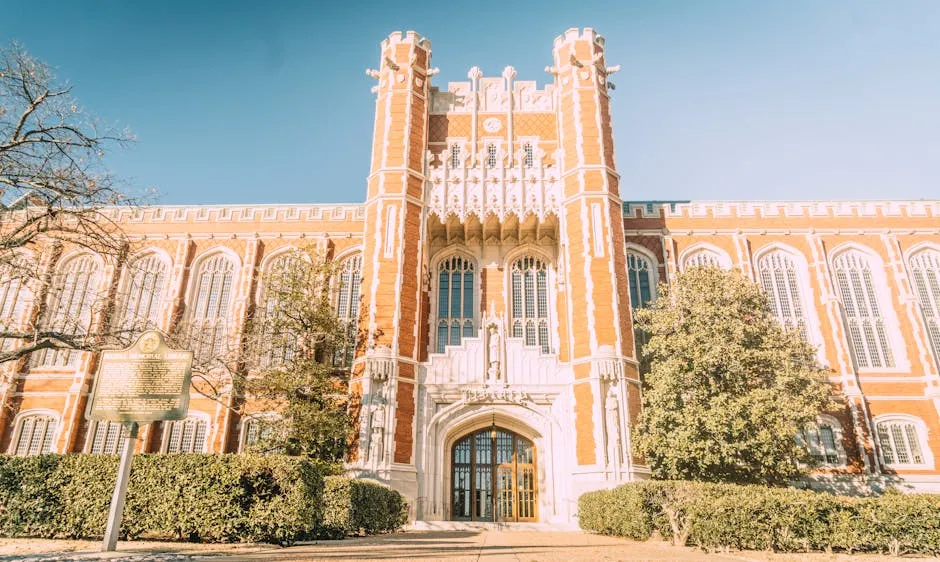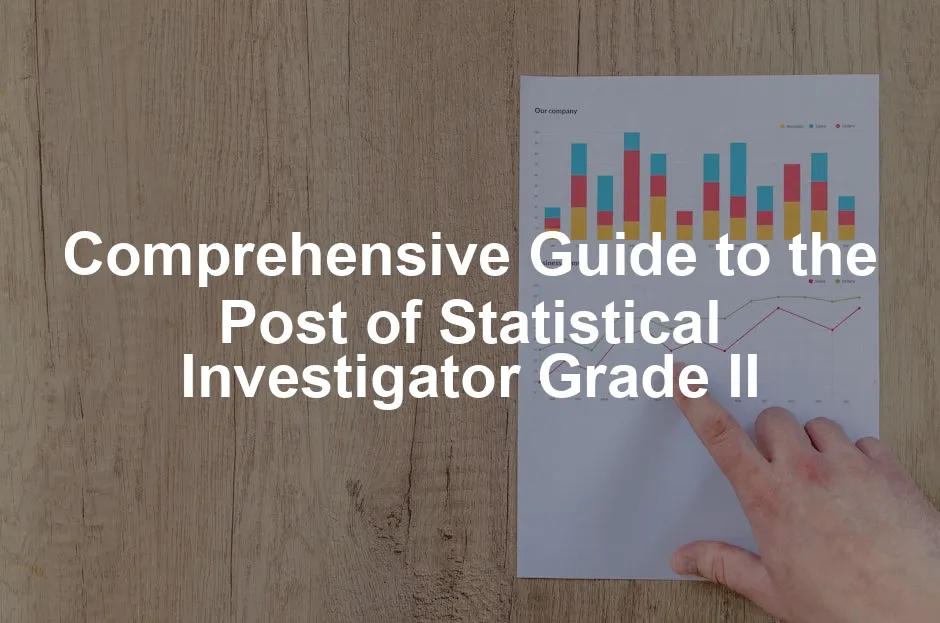Introduction
The SSC CGL exam is one of India’s most competitive recruitment drives. Each year, the Staff Selection Commission (SSC) conducts this exam to recruit candidates for various posts across multiple ministries and departments. Among these coveted positions is the Statistical Investigator Grade II, a role that combines statistical analysis with real-world implications.
Statistical Investigator Grade II holds a critical position within the government. This role is vital for collecting and analyzing data, which in turn shapes policies and programs. It’s not just about crunching numbers; it’s about making sense of them in a way that can impact millions. The responsibilities include conducting surveys, preparing reports, and assisting in the decennial census. Thus, this position is not only prestigious but also essential for the nation’s statistical framework.
If you’re looking to dive deeper into statistical concepts, you might want to check out Statistics for Dummies. This book breaks down complex ideas into easy-to-understand concepts, making it perfect for beginners!
This article aims to provide a comprehensive understanding of the Statistical Investigator Grade II role. We will discuss job responsibilities, salary, eligibility criteria, the selection process, and opportunities for career growth. Whether you’re an aspiring candidate or simply curious about government jobs, this guide will equip you with all the necessary information.

SSC CGL Statistical Investigator Grade II Overview
What is SSC CGL?
The Staff Selection Commission (SSC) serves as the backbone of government recruitment in India. It conducts various exams to fill positions across different levels. One of the most significant is the Combined Graduate Level (CGL) exam, which opens doors to numerous Group B and Group C posts.
The CGL exam is structured in tiers. Tier 1 is a preliminary objective test, while Tier 2 consists of more in-depth assessments. Candidates must excel in both tiers to be considered for the next stages, which include document verification and interviews. This rigorous selection process ensures that only the best candidates make it through.
Role of Statistical Investigator Grade II
The Statistical Investigator Grade II position falls under the umbrella of the Ministry of Statistics and Programme Implementation. It is classified as a Group B post, which signifies its importance within the government structure. Individuals in this role are tasked with executing crucial data collection initiatives, including but not limited to the decennial census.
Statistical Investigators play an essential part in the office of the Registrar General of India. Their work directly influences national planning and policy formulation. From conducting surveys to analyzing socio-economic data, every task carries weight. Their findings contribute to understanding demographic trends, economic indicators, and much more. Overall, the Statistical Investigator Grade II role is not merely a job; it’s a stepping stone toward making a difference in the community and the nation at large.
To enhance your skills in data analysis, consider getting your hands on Statistical Analysis Software. It streamlines the process and helps you analyze data like a pro!

Key Responsibilities of Statistical Investigator Grade II
Job Profile
The Statistical Investigator Grade II is like a superhero of data! Their primary mission? Collecting and analyzing essential information that fuels government decisions. This role is pivotal in shaping policies and understanding societal trends.
First and foremost, data collection is at the heart of this job. Investigators venture into the field, armed with surveys to gather socioeconomic data. They engage with the public to collect insights on various issues. Think of them as friendly detectives, unraveling the mysteries hidden in numbers!
Once the data is collected, the fun really begins. Statistical Investigators dive into analysis. They sift through the raw data, identifying patterns and trends. This is where their skills come into play. They use statistical tools to ensure accuracy and reliability. Their findings contribute to national statistics and reports. These reports help guide government programs and policies, impacting millions of lives.
Conducting surveys is another critical responsibility. Investigators craft surveys that capture the right information. They ensure that questions are clear and relevant. After gathering the data, they prepare reports that summarize their findings. These reports are presented to higher authorities, making their work essential for effective governance.
Moreover, Statistical Investigators play a significant role during the census. They assist in organizing and executing the decennial census, which is no small feat! This involves planning, monitoring fieldwork, and ensuring that every corner of the nation is covered. Their work ensures that the census data is comprehensive and accurate.
Lastly, they engage in statistical research. This can include collaborations with other departments to produce insightful studies. Their expertise helps in understanding demographic changes, economic indicators, and more. Overall, the role of Statistical Investigator Grade II is multifaceted, combining fieldwork, analysis, and reporting to contribute to the nation’s statistical framework.
If you’re keen on mastering statistical concepts, you should check out R for Data Science. It’s a great resource for anyone looking to dive into data analysis!
Work Environment
Now, let’s talk about the work environment! Picture this: a blend of office space and the great outdoors. Yes, the life of a Statistical Investigator is not confined to a desk. They often find themselves in diverse settings, from bustling cities to rural areas.
In the office, they analyze data and prepare reports. It’s a space filled with computers, statistical software, and a team of like-minded data enthusiasts. Here, they can collaborate with colleagues, exchange ideas, and refine their findings. It’s a friendly atmosphere where crunching numbers is a daily affair.
But wait, there’s more! Fieldwork is an exciting aspect of their job. Investigators step out into the real world to gather data. They might visit households, conduct interviews, or even oversee survey operations. This part of the job can be dynamic and sometimes challenging. Weather conditions, travel requirements, and interacting with diverse populations keep things interesting!
Fieldwork can be particularly demanding during census periods. Investigators must ensure every household is reached, which means long days and extensive travel. However, the satisfaction of contributing to a national initiative makes it worthwhile.
Data processing duties also play a part in their role. After collecting data, they return to the office to analyze and interpret it. This part requires attention to detail and a keen analytical mind. In essence, the work environment of a Statistical Investigator Grade II is a mix of engaging field experiences and analytical office tasks, making it both dynamic and fulfilling.

Eligibility Criteria for Statistical Investigator Grade II
Educational Qualifications
To embark on the journey to become a Statistical Investigator Grade II, the first step is education! Candidates need a Bachelor’s Degree, specifically with Statistics as one of their subjects. A solid understanding of statistical principles is crucial for success in this role.
Universities and institutes offer various programs, but the focus should always be on statistics. Having a strong foundation in this subject will make the data analysis tasks much easier. In some cases, candidates with degrees in related fields may also be considered, provided they have studied statistics comprehensively.
For those wanting to deepen their understanding, The Art of Statistics: Learning from Data is a fantastic read that can provide the insight you need!

Age Limit
Age matters, especially in government jobs! For the Statistical Investigator Grade II position, candidates must be between 18 to 30 years old. This age limit ensures that the workforce remains dynamic and brings fresh perspectives to the table.
However, there are relaxations in the upper age limit for certain categories. OBC, SC, ST, and others may enjoy additional years added to the maximum age. So, if you’re in those categories, it’s time to check how old you can be while aiming for this coveted position!
Nationality
Lastly, let’s talk about nationality requirements. To apply for the Statistical Investigator Grade II post, candidates must be citizens of India. However, the eligibility extends to subjects of Bhutan and Nepal and Tibetan refugees who came to India before January 1, 1962.
This inclusiveness reflects the government’s commitment to diversity while ensuring that the workforce is primarily made up of Indian citizens. So, if you’re a proud Indian or belong to one of the specified groups, you’re already on the right track!
In summary, the eligibility criteria for the Statistical Investigator Grade II position are straightforward: a Bachelor’s Degree with a statistics focus, adherence to the age limit, and nationality requirements. With these qualifications, aspiring candidates can set their sights on this exciting career in government statistics!

Salary Structure and Allowances
Salary Breakdown
The salary for a Statistical Investigator Grade II is structured to provide a competitive income within the government framework. The basic pay starts at ₹35,400, categorized under Pay Level 6 as per the 7th Central Pay Commission. This positions the Statistical Investigator Grade II comfortably within the Group B cadre.
The pay scale ranges from ₹35,400 to ₹1,12,400, reflecting the potential for growth as one gains experience. The grade pay associated with this position is ₹4,200, further enhancing the overall compensation.
But what does this mean for the in-hand salary? Well, it varies based on the posting location. For those stationed in ‘X’ cities—think bustling metropolises like Delhi, Mumbai, and Bengaluru—the in-hand salary can range between ₹46,000 to ₹55,000 monthly. The higher cost of living in these areas is offset by additional allowances.
In contrast, if you’re in ‘Y’ cities like Jaipur or Kanpur, your monthly take-home might drop to around ₹40,000 to ₹50,000. And for our friends in ‘Z’ cities—rural or less populated areas—the in-hand salary could be approximately ₹35,000 to ₹45,000.
This tiered salary structure is designed to ensure that all Statistical Investigators receive fair compensation relative to their cost of living. So whether you’re living it up in a metropolitan area or enjoying the serenity of the countryside, there’s a salary that fits your lifestyle.
And speaking of salary, if you want to learn how to measure everything, consider checking out How to Measure Anything. This book provides fascinating insights into quantifying the unquantifiable!
Additional Allowances
Now, let’s sprinkle in the additional allowances that make this job even more attractive. First up, the House Rent Allowance (HRA). Depending on your city classification, HRA can significantly boost your income. For instance, in ‘X’ cities, it can be as high as 24% of your basic salary, translating to ₹8,496. In ‘Y’ cities, it drops to 16%, equating to ₹5,664, while in ‘Z’ cities, it’s around 8%, or ₹2,832.
Next, let’s talk about the Dearness Allowance (DA). This allowance is crucial for offsetting inflation and is currently around ₹12,036. It serves as a safety net against rising living costs, ensuring your purchasing power remains intact.
And let’s not forget about the Travelling Allowance (TA). For employees in ‘X’ cities, it can be ₹4,824, helping cover commuting costs. For those in other areas, the TA is halved, making it a nice little bonus for your travel expenses.
All these allowances collectively enhance the overall compensation package, making the Statistical Investigator Grade II position not only a rewarding career choice but also a financially stable one.
Promotion and Career Growth Opportunities
Career Progression
When it comes to career growth, the Statistical Investigator Grade II position offers a promising trajectory. Starting as a Statistical Investigator, one can aspire to climb the ranks within the organization.
After approximately five years of service, you can be promoted to Statistical Investigator Grade I. This elevation not only comes with increased responsibilities but also a pay hike that reflects your enhanced expertise.
Further down the line, ambitious individuals can aim for roles like Assistant Director of Census Operations, which typically requires three years of selection and promotion. The ultimate dream? Positions like Deputy Director or even Joint Director of Census Operations—these roles can be within reach after several years of dedicated service and exemplary performance.
For those looking to enrich their knowledge base, consider grabbing a copy of The Data Science Handbook. It’s an excellent resource for anyone looking to make a mark in the data science field!

Factors Influencing Promotions
Promotions within this governmental structure hinge on several factors. Seniority plays a significant role; the longer you serve, the more likely you are to advance. However, performance cannot be overlooked. Consistent excellence in your work can set you apart from your peers.
Additionally, departmental exams can create opportunities for advancement. By successfully passing these exams, candidates can earn promotions faster and secure higher positions.
In summary, the path for a Statistical Investigator Grade II is not just about numbers and data; it’s about building a rewarding career in public service, with ample opportunities to grow and flourish.
Selection Process for Statistical Investigator Grade II
Examination Structure
The selection for the Statistical Investigator Grade II post is a rigorous two-tier examination process. It ensures only the best candidates make it through the competitive landscape of government jobs.
Tier 1 Examination serves as the screening round. This objective-type test comprises 100 multiple-choice questions across four sections: General Intelligence and Reasoning, General Awareness, Quantitative Aptitude, and English Comprehension. Each question carries two marks, making the total score 200. Candidates have one hour to complete this exam. Negative marking applies, with a deduction of 0.50 marks for each incorrect answer.
Tier 2 Examination is where the real fun begins! Candidates who qualify Tier 1 move on to this stage, which consists of multiple papers. Paper I is mandatory for all candidates and focuses on Quantitative Abilities, featuring 100 questions for a total of 200 marks. Candidates are given 2 hours and 30 minutes to tackle this paper. Additionally, candidates applying for the Statistical Investigator role must take Paper II, which tests their English Language and Comprehension skills.
Here’s a brief breakdown of the subjects covered:
- Tier 1:
- General Intelligence and Reasoning
- General Awareness
- Quantitative Aptitude
- English Comprehension
- Tier 2:
- Paper I: Quantitative Abilities (100 questions, 200 marks)
- Paper II: English Language and Comprehension (100 questions, 200 marks)
Marking in Tier 2 also includes negative marking: 1 mark is deducted for each incorrect answer in Paper I, while Paper II deducts 0.50 marks. This structure tests not only knowledge but also precision and speed under pressure.
Document Verification and Medical Examination
Once candidates successfully navigate through both tiers of the examination, they face the next steps: document verification and medical examination.
During document verification, candidates are required to provide essential documents to validate their eligibility. This includes educational certificates, identity proof, and other relevant documents. It’s crucial to ensure that all details match the information provided in the application form. Any discrepancies may lead to disqualification.
Following document verification is the medical examination. This step assesses the physical and mental fitness of candidates to ensure they are capable of performing their duties effectively. Candidates must meet specific health standards set by the commission, which includes both general health evaluations and any role-specific requirements.
Successfully passing through these stages confirms that a candidate is not only knowledgeable but also fit for the demanding yet rewarding role of a Statistical Investigator Grade II. The entire selection process is designed to bring forth candidates who are well-prepared for their responsibilities in the realm of government statistics.

Comparison with Similar Positions
Statistical Investigator Grade II vs. Junior Statistical Officer
When comparing the Statistical Investigator Grade II with the Junior Statistical Officer (JSO) role, it’s essential to identify their distinct responsibilities and work environments. Both positions are crucial in the realm of statistics but cater to different functions within the government framework.
The Statistical Investigator Grade II primarily operates under the Registrar General’s office, focusing on census-related activities. Their responsibilities include data collection, analysis, and the execution of field surveys. They ensure accurate data representation that influences national policies. Field operations and direct public interaction are hallmarks of this role.
In contrast, the Junior Statistical Officer often functions under the National Sample Survey Office (NSSO). This role is more inclined towards conducting sample surveys and analyzing data pertaining to socio-economic factors. While both positions require strong analytical skills, the JSO’s work revolves around sampling methodologies and statistical evaluation rather than the comprehensive data collection seen in the Statistical Investigator role.
Salary structures for both positions are comparable, as they fall within similar pay bands. However, the primary difference lies in their career progression and the nature of the work environment. The Statistical Investigator often experiences more fieldwork, while JSOs may spend more time in office settings analyzing data.
Other Related Positions in Government
In addition to the Statistical Investigator Grade II and Junior Statistical Officer roles, several other government positions share similarities. For instance, the Statistical Assistant and Research Assistant positions provide further avenues for candidates interested in statistics and data analysis.
Statistical Assistants typically work on data processing, involved in the preparation of statistical reports and assisting senior officials in analysis. Their role is generally more office-based and less field-oriented compared to Statistical Investigators.
On the other hand, Research Assistants often engage in statistical research projects, focusing on specific studies or surveys. Their work can vary widely depending on the department but generally includes assisting with data collection and analysis, similar to the Statistical Investigator role but with a narrower focus.
Overall, while these positions share foundational skills in statistics and data analysis, each offers unique responsibilities and environments, catering to different aspects of government operations. Whether one prefers fieldwork or office-based analysis, opportunities abound for those passionate about statistics in the public sector.

Conclusion
The Statistical Investigator Grade II post is a gem in the treasure chest of government jobs. Why? Because it plays a crucial role in shaping policies and making informed decisions based on statistical data. By collecting and analyzing data, Statistical Investigators help ensure that government programs are effective and cater to the needs of the public. It’s like being a data superhero, wielding numbers to make a real difference!
Candidates preparing for the SSC CGL examination should take this opportunity seriously. The competition is fierce, but with the right preparation, you can emerge victorious. Start by understanding the syllabus, practicing previous years’ papers, and keeping up with current trends in statistics. Embrace the challenge; after all, every great achievement begins with the decision to try.
If you’re interested in furthering your knowledge, consider picking up The Elements of Statistical Learning. This book dives deep into data mining and prediction, making it a must-read for aspiring statisticians!
And let’s not forget the career opportunities that await you within the field of statistics in government services. From promotions to higher roles like Assistant Director or Deputy Director, the path is filled with potential. Not only do you get to enjoy a stable job, but you also gain respect in a field that is integral to national progress. So, roll up your sleeves, hit the books, and get ready to embark on an exciting journey as a Statistical Investigator Grade II!
If you’re interested in the role of Statistical Investigator Grade II, you can find more details in this relevant post: Statistical Investigator Grade II.
FAQs
What are the main responsibilities of a Statistical Investigator Grade II?
Statistical Investigators primarily focus on collecting and analyzing data. They conduct surveys, prepare reports, and assist in national census activities. Their work is vital for creating accurate statistical databases that inform government policies.
What is the minimum educational qualification required for this post?
To apply for the Statistical Investigator Grade II position, candidates must hold a Bachelor’s Degree with Statistics as one of the subjects from a recognized institution. Strong statistical knowledge is essential for success in this role.
What is the starting salary for a Statistical Investigator Grade II?
The starting salary for this position is approximately ₹35,400 per month. However, this can vary based on the posting location, with in-hand salaries ranging from ₹46,000 to ₹55,000 in metropolitan areas.
Is there a training period for new recruits?
Yes, new recruits undergo a four-week training period. This training focuses on statistical tools and demographic analysis, equipping them with the necessary skills to excel in their roles.
What is the promotion structure for Statistical Investigators?
Promotions for Statistical Investigators typically occur based on seniority and departmental exams. After five years of service, they can advance to Statistical Investigator Grade I, with further opportunities to rise to roles such as Assistant Director and Deputy Director. The career progression is promising for dedicated individuals.
Please let us know what you think about our content by leaving a comment down below!
Thank you for reading till here 🙂
All images from Pexels




